
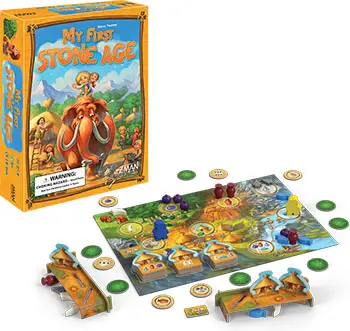
Components
- 1 game board
- 4 settlements
- 4 player markers
- 4 player figures
- 20 goods
- 15 hut tokens
- 2 dog tokens
- 14 forest tokens
- rulebook
Jono and Jada, the Stone Age Children
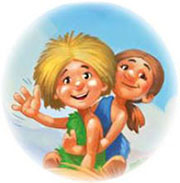
In the Stone Age, 10,000 years ago, people lived life very differently than they do today.
They worked hard building simple huts, hunting, and gathering berries and mushrooms to eat.
They lived their lives surrounded by nature. When the sun went down, they would gather around the fire for light and warmth.
During this time, there was a little a boy named Jono. He had shaggy blond hair and was quite strong for his age. Jono had an older sister named Jada. She had the same knobbly nose as her brother. Jono and Jada were inseparable.
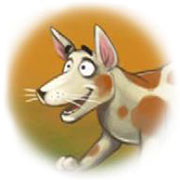
Their best friend was their wolfhound, Guff. They found him in front of a bear's lair when he was just a puppy.
They were afraid the bear would find Guff, so they took him home and looked after him. Since then, Guff has never left their side.
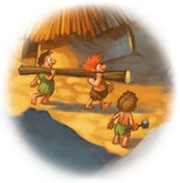
The children of the Stone Age had it pretty tough. They had to help their parents with a lot of hard work, so they didn't have a lot of time to play.
Jono and Jada were very good about helping their family with their daily tasks.
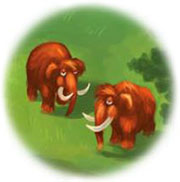
Just like people lose their baby teeth and get new teeth, mammoths get new teeth six times during their lives!
Sometimes mammoths lose their teeth while eating the delicious grass in this marshy meadow, and Jono and Jada go there to collect the teeth that are left behind.
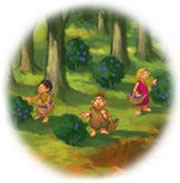
The children also help by picking berries in the forest. That work wasn't very hard, because there were just so many berries. But the berries were so delicious that the children would nibble on them.
Their mother would often wonder how the children could spend so long in the bush, yet bring home so few berries.
There's a spot behind the forest where the soil is slippery and soft.
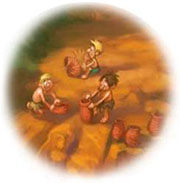
The children's uncle, Nubu, discovered the same soil under a fire, except it was much harder.
Nubu used this knowledge to make bowls and plates and harden them in the fire.
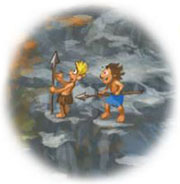
Up in the mountains, the children could find stones of all different shapes and sizes. Some of them had very hard, sharp edges.
Jono and Jada take arrowhead stones to a man in the village who makes them into primitive tools and weapons.
The children are very careful when taking these tools to their family in the valley.
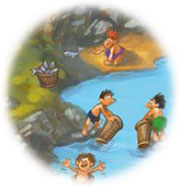
On their way to the valley, the children love walking past the river.
The villagers there use sticks and handmade baskets to catch fish, and Jono and Jada are always happy to help.
And look! Guff jumped into the water for a quick bath.
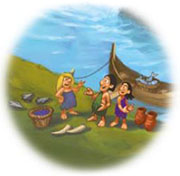
There was no such thing as money in the Stone Age. If a family needed something they couldn't make themselves, then they had to trade something for it.
Families in neighboring valleys would gather to exchange their goods. Jono and Jada were always excited to see what their neighbors would bring.
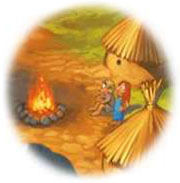
In the evening, the children made their way back to the village. There was still plenty of work to be done in the huts.
And, as the sun finally set and another eventful day came to an end, the whole village would gather by the big fire to share exciting stories of days gone by.
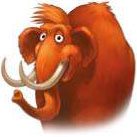
In this game, you can pretend to live as a person in the Stone Age.
Explore the valley and collect the different goods. Then trade those goods at the building site and watch your settlement grow.
Setup
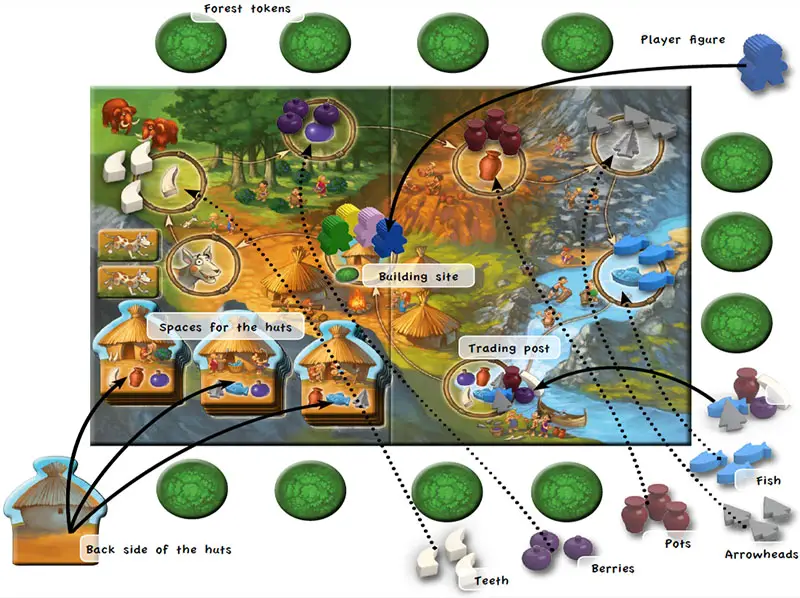
-
Place the game board in the middle of the table.
2.Each player chooses a color and takes the settlement with the mammoth in their color. During the game, goods and huts will be placed on a player's settlement.

-
Each player takes the player figure and the player marker of their color. Place the figure on the building site in the middle of the board and place the marker in front of you.

You will move the figure around the game board to collect different goods. If playing with less than 4 players, place the unused player figures and markers in the box.
-
Now you place the goods where they belong on the board. If you are playing with 3 or 4 players, you will use 4 of each good (berry, fish, pot, arrowhead, tooth).

If playing with only 2 players, you will only use 3 of each good (place the unused goods in the box). Place exactly 1 of each good on the trading post.
-
Set the remaining goods on their corresponding spaces of the game board. The teeth are placed with the mammoths in the swamp; the berries by the bushes in the forest; the pots in the clay area; the arrowheads with the artisans on the mountain and the fish by the fishermen in the river.
-
Shuffle the hut tokens face down (so that the goods cannot be seen). Make 3 piles of 5 huts each, and place them on the 3 hut spaces at the bottom left of the board. Then flip the first tile of each pile face up.
-
Place the 2 dog tokens on the spaces provided for them on the board.
-
Shuffle the forest tokens and placed them face down (forest side up) so that they surround the game board. There should be 4 tokens both above the board, 4 below the board, 3 to the left, and 3 to the right.
Object of the Game
You are trying to collect different goods and spend them at the building site  to build huts
to build huts  .
.
The first player to build 3 huts wins the game.
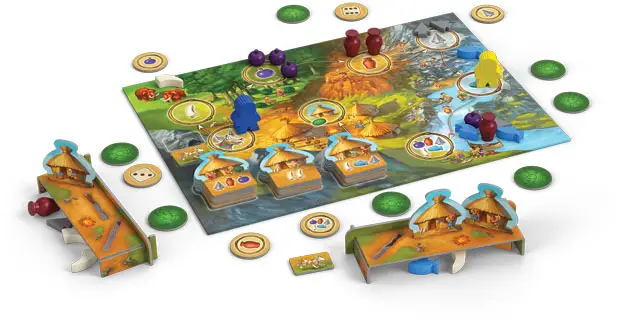
Game Play
Players take turns in clockwise order. The youngest player starts. On your turn, perform the 3 following steps:
- Flip over a forest token
- Move your figure
- Perform an action
Then, the next player in clockwise order gets to play his turn.
1. Flip Over a Forest Token
Flip over 1 of the forest tokens currently facedown. The revealed forest token tells you what you do on your turn.
Example: Flip over 1 forest token.
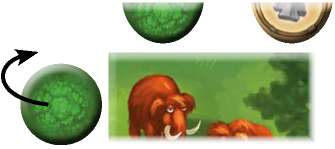
2. Move your Figure
Your forest token has a die on it
If your forest token has one of these dice:

Move your figure in the direction of the arrows by a number of spaces equal to the number of pips on the die.

Example: You flipped over the forest token that has a die with 2 pips.
You move your figure 2 spaces forward, moving from the building site to the tooth site.
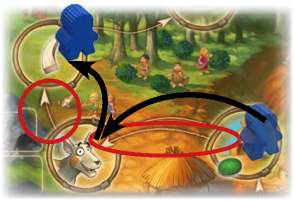
Your forest token has a symbol on it
If your forest token has one of these symbols:
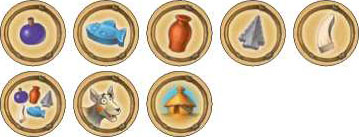
Move your figure directly to the space on the board that matches that symbol.

Example: You flipped over the forest token that has a fish on it.
Move your figure directly to the fish space.
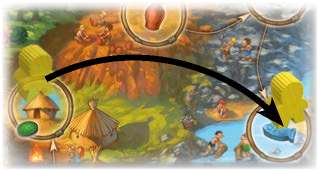
3. Perform an Action
Which action space did you land on?
Whenever you move to a space, you can perform an action there. The action you perform depends on what space you land on.
-
 berry,
berry,  fish,
fish,  pot,
pot,  arrowhead, or
arrowhead, or  tooth
toothTake 1 good from the space you landed on and place it behind your settlement. You are allowed to hide your goods from the other players.
If the space you landed on is empty, then that's bad luck! You don't get anything this turn.
-
 Trading Post
Trading PostTrade as many goods from your settlement with the trading post as you wish. You may trade as many or as few as you would like.
Each good you take from the trading post must be replaced with one from your settlement.
The goods you take are placed behind your settlement, and the goods you trade away are placed on the trading post space. There should
-
 the Dog Space
the Dog SpaceTake 1 dog token and place it next to your settlement so that the other players can see it.
If there are no dog tokens next to the dog space, you may steal one from another player. If the dog tokens are held by 2 different players, you must steal the dog token from the closest player to your left who has one.
If you already have both dog tokens in front of you when you land on the dog space, then you simply do not take anything.
The dog tokens will help you build huts (see the construction site rules).
-
 Construction Site
Construction SiteWhen you land here, you perform 2 actions: build 1 hut (optional) and turn all forest tokens face down (mandatory).
-
Build
 1 hut
1 hutDo you have all the goods pictured on 1 of the available huts?
If so, take those goods from behind your settlement and return them to their appropriate spaces on the board to build that hut (berries to the berry space, fish to the fish space, etc)..
Then take the hut you built and place it one of the three slots on your settlement.
If you do not have enough goods to build any of the huts, then you may not place a hut on your settlement this turn.
You may only build 1 hut per turn.
Did you build a hut this turn? Then you must reveal a new hut (the face down hut that was underneath the hut you built). Is that pile of huts empty? Then there will only be 2 face up huts from now on.
 Dog tokens
Dog tokensA dog token is a joker. That means that when you want to build a hut, you may use a dog token in place of one of the goods you need to build a hut.
Return 1 dog token to the dog space, and pay 1 less good than pictured on the hut. Then place the hut in a slot on your settlement.
If you have both dog tokens, you may use both of them when building a hut.
-
 Turn the forest tokens face down
Turn the forest tokens face downWhenever you land on the construction site, you must turn all the revealed forest tokens face down. It doesn't matter whether you built a hut or not.
Then you must swap the positions of 2 of the forest tokens. Make sure everyone watches you do it.
-
End of the Game
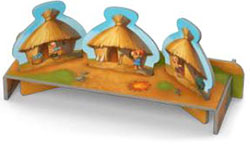
The game ends immediately when someone has built their 3rd hut.
Their settlement is complete and they are the winner. !
Continue Reading



